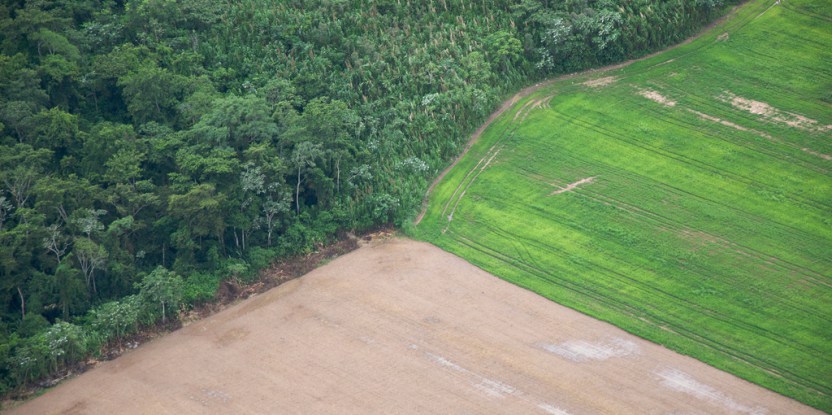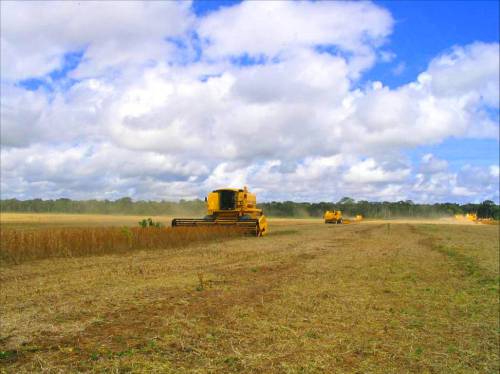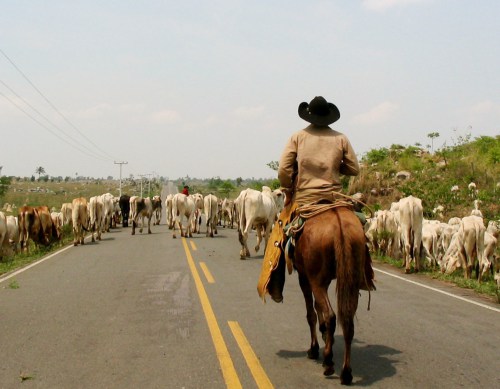
BOGOR, Indonesia—In Bolivia, Mother Earth has the right to life, biodiversity, clean water and air, equilibrium, restoration and pollution-free living. That law, passed in 2012, gives humans the duty to protect those rights.
But the landlocked country in the heart of South America is also committed to expanding food production to meet the needs of its growing population, and to using its land and forests for economic growth.
As in many other tropical countries, those two goals are on a collision course, according to a study of deforestation and forest degradation in the Bolivian Amazon.
Much of Bolivia’s tropical forest, located in the country’s lowlands, has been threatened by soy farming and by the expansion of cattle ranching. Deforestation rates are stable though relatively high, at about 200,000 hectares a year, according to the study by the Center for International Forestry Research (CIFOR).
In the early 2000s, the Bolivian government expressed interest in making use of market mechanisms, such as carbon trading, to curb deforestation and forest degradation.
But that approach changed after President Evo Morales took office in 2006.
Besides passing legislation that spelled out the rights of Mother Earth and the duty of Bolivia’s government and citizens to protect her, the country backed away from market-based conservation incentives such as Reducing Emissions from Deforestation and forest Degradation (REDD+).
“Bolivia has been working to make non-market alternatives visible in international negotiations about climate change,” said Pablo Pacheco, a principal scientist at CIFOR.
The Mother Earth Law makes land rights a collective matter of public interest and establishes the rights of indigenous peoples, rural dwellers, and Afro-Bolivian and intercultural communities. But there are contradictions between that law and other norms promoting the expansion of industrial agriculture and food sovereignty, which could lead to more clearing of forests, the study states.
A CHALLENGING BALANCE
About 80 percent of Bolivia’s 50 million hectares of forest are in the Amazonian lowlands, traditionally occupied by native ethnic groups that used forest products without having much impact on the forest.
Large-scale logging that began in the 1960s sparked conflicts between timber companies and indigenous forest dwellers. When indigenous communities stepped up demands for territorial rights in the 1990s, the government responded by establishing “indigenous native peasant territories” (known by their Spanish acronym, TCOs) that recognized the customary rights of indigenous people to their lands.
The challenge is to find ways to reconcile food production with forest protection, and to decouple agricultural growth, which has an important role in meeting food security goals, from deforestation
Other legislation in the 1990s established forest concessions that supported sustainable forest management by communities. This legislation has been modified over time to support integrated forest management, and recently has been established a program for promoting timber plantations and reforestation. In addition, titling programs have helped make land tenure more secure. Increasing attention to timber legality verification, meanwhile, has decreased illegal logging, although implementation is still ongoing, according to the study.
With the best agricultural land now taken, soybean expansion has slowed, and cattle ranching has become the leading cause of destruction of Bolivia’s lowland forests, the study says. About 50 percent of deforestation is due to ranching, 30 percent to industrial crops and 20 percent to small farmers, says study co-author Robert Müller of the University of Göttingen.
Bolivia has announced a goal of food sovereignty—producing the food it needs to feed its growing population. But that could increase pressure to turn forests into farmland.
Deforestation in Bolivia increased from about 51,000 hectares a year between 1976 and 1986 to 205,000 hectares a year between 2006 and 2010. Between 1992 and 2001, deforestation in the country caused the loss of 277 million tons of biomass, releasing 56 million tons of carbon dioxide (CO2) into the atmosphere. In the next decade, 2001 to 2010, biomass loss rose to 424 million tons and CO2 emissions totaled 77.8 million tons.
In 2010, the country approved a national climate change strategy that specifically mentions the role of forests in mitigating climate change and helping local people adapt. But a new Constitution approved in 2009 decentralized public administration, including forest management, and the distribution of responsibilities at the local, regional and national levels are not completely clear, the study says.
CARBON MARKETS ALTERNATIVE?
The market-based schemes that Bolivia has rejected have been a key agenda point at international climate summits leading up to a new treaty to replace the Kyoto Protocol. A new deal is expected to be signed in Paris in late 2015.
Bolivian officials argue that the commercialization of nature through devices such as carbon markets work against the rights of Mother Earth and tends to undermine the capacities of people who depend on the country’s forests for their livelihoods.
They also contend that carbon trading does not attack the root cause of greenhouse gas emissions, because it enables businesses in industrialized countries to maintain their emissions as long as they offset them elsewhere.
At the 2010 UN climate summit in Mexico, Bolivia insisted on respect for indigenous people’s rights, an emphasis on adaptation as well as mitigation, avoiding market mechanisms and forbidding forests to be cleared for tree plantations or infrastructure. The government has since modified its position slightly, accepting that countries could use market mechanisms, but calling for non-market-based incentives as well.
To implement its proposals for non-market REDD+, Bolivia established the Joint Mitigation and Adaptation Mechanism for the Integrated and Sustainable Management of Forests and Mother Earth, which encourages political, technical and operational coordination, and provides for fundraising. In addition, the government has created an agency, the “Plurinational Authority of Mother Earth,” to support this process.
This office has initiated actions in support of integrated land and forest management in the Department (province) of Pando, as well as in five municipalities in the Department of Santa Cruz. While the state provides with some resources, there is also involvement of some international donors and support from FAO and UNEP.
Bolivia’s non-market proposal for reducing deforestation focuses heavily on smallholders, but their farming practices are not the main cause of deforestation in the country. Bolivian policy makers must analyze and target the major drivers, cattle ranching and industrial-scale agriculture, Müller says.
Higher intensity—more cattle per hectare—could reduce ranching’s impact by making it more efficient, the study says. Limiting mechanized agriculture to areas with suitable soil and ending diesel subsidies could curb deforestation from industrial farming. Better local zoning, along with incentives to adopt sustainable farming practices, could reduce deforestation by smallholders.
While Bolivia is arguing in the international agenda in favor of protecting the rights of Mother Earth, internally there is significant political pressure for expanding the agricultural frontier based on discourses of food security. Ultimately for Bolivia, and other tropical forest countries grappling with climate change mitigation, the challenge is to balance food production with forest protection, and at the same time improve the consistency between the position at the climate change negotiations with the internal policy agenda.
“This is not specific to Bolivia,” Pacheco said. “Many other countries face this contradiction. The challenge is to find ways to reconcile food production with forest protection, and to decouple agricultural growth, which has an important role in meeting food security goals, from deforestation.”
For more information on the topics of this research, please contact Pablo Pacheco at p.pacheco@cgiar.org.
This research was carried out as part of the Global Comparative Study on REDD+ and the CGIAR Research Program on Forests, Trees and Agroforestry and was supported in part by NORAD, AusAID, DFID, the European Commission, the Department for International Development Cooperation of Finland, and the David and Lucille Packard Foundation.
We want you to share Forests News content, which is licensed under Creative Commons Attribution-NonCommercial-ShareAlike 4.0 International (CC BY-NC-SA 4.0). This means you are free to redistribute our material for non-commercial purposes. All we ask is that you give Forests News appropriate credit and link to the original Forests News content, indicate if changes were made, and distribute your contributions under the same Creative Commons license. You must notify Forests News if you repost, reprint or reuse our materials by contacting forestsnews@cifor-icraf.org.

